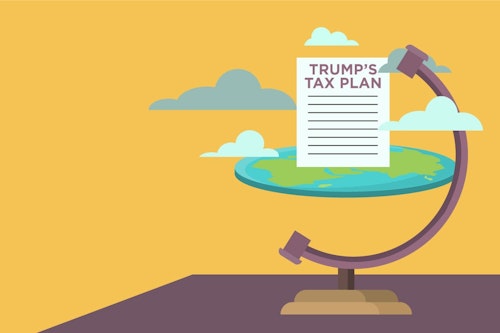The Flat Earth Tax Plan: Trump’s Proposal is Over the Edge

Treasury Secretary Steve Mnuchin promises President Trump’s tax cuts will pay for themselves. They won’t, and they can’t. The idea that tax cuts of the magnitude proposed by President Trump can possibly spur economic growth to the level necessary to make this plan revenue neutral (or even in the ballpark) is a fallacy.
This notion traces back at least 40 years to economist Arthur Laffer, who outlined the vague economic concept on a back of a napkin, and it has since become tax policy dogma for some conservatives.
It is time to discard the napkin. There is theoretically a tax rate above which revenue would drop, but our income rates aren't anywhere near that theoretical territory. When empirically analyzed and tested with real-world data, Laffer’s supply-side economics thinking on tax cuts fall apart. Aside from economic studies, we’ve seen this before in real life, and it has never come close to raising the revenue promised.
We desperately need real tax reform, and there is a way to make the code progressive, competitive, pro-growth, and responsible. But let’s stop selling the false promise that massive tax cuts pay for themselves.
At one time, the greatest minds believed the world was flat. Then scientists theorized otherwise. And after the scientists did their work, actual explorers proved it. The Trump tax plan is a Flat Earth Society anachronism. The theory has been proven wrong on paper and in practice. And here are eight examples as to why the earth is round and the Trump plan fails to acknowledge basic truths.
- Historically, unpaid tax cuts have slowed growth. In a paper published last year, Andrew Samwick and William Gale cite historical evidence pointing to the fact that tax cuts financed by debt will have little positive impact on long-term growth and could reduce growth.
- Nonpartisan analysis shows the Trump plan, specifically, would slow economic growth because of massive deficits. The Tax Policy Center, in collaboration with the Penn Wharton Budget Model, analyzed the Trump campaign plan. Even accounting for the positive effects of tax cuts, on net, growth would be lower under the plan. That’s because rising budget deficits would push up interest rates and crowd out private investment. Whether the most recently proposed plan has the same effect will depend on its ultimate price tag.
- In order to “pay for” the cost of Trump’s plan, the economy would have to grow at a simply unattainable pace. As the Committee for a Responsible Federal Budget has written, growth is projected to be 1.8% over the next decade. The promises of 3% growth (and sometimes higher) coming out of the administration may be reachable for one or two quarters, but averaging that over a decade would defy new economic realities, including an aging population and slow productivity growth.
- The last time we did this with the Bush tax cuts, the federal debt increased by $2.8 trillion over two administrations. Far from paying for themselves, the Bush tax cuts drove up the deficit, exacerbated income disparities, and left the middle class with stagnant median wages.
- Tax cuts at the top, where Trump’s plan is focused, have not grown the economy at all in the past. The nonpartisan Congressional Research Service concluded, “reduction in top tax rates have had little association with saving, investment, or productivity growth.”
- Tax cuts might actually reduce incentives to work, save, and invest. Andrew Samwick and William Gale conclude that rate cuts would “raise the after-tax income people receive from their current level of activities, which lessens their need to work, save, and invest.”
- Tax cuts undermine public investments, which hurts growth. Alan Auerbach found that, in the longer run, the reductions in public investment in things like infrastructure necessitated by tax cuts would harm saving and output.
- Kansas tried it, and failed. In 2013, Governor Sam Brownback and the state of Kansas cut personal and business income tax rates substantially. Then, tax revenue dropped precipitously. Why? The economy faltered. In a 2016 nonpartisan economic report, the Kansas economy ranked 46th among states, with personal income growth just half the national average and sixth worst in the nation. “It refutes everything we’ve been told, the spin that Sam Brownback’s given us, that we have an economic boom here in the state,” said Minority Leader Anthony Hensley, recalling that Brownback promised that income tax cuts would be a “shot of adrenaline” to the Kansas economy.
Of course, ballooning deficits aren’t the only problem with Trump’s tax cuts. They don’t actually simplify the code, as Trump claims, and they’re largely tilted toward the wealthy, and in particular, the Trump family itself. Maybe there is a method to this madness after all.
Subscribe
Get updates whenever new content is added. We'll never share your email with anyone.
